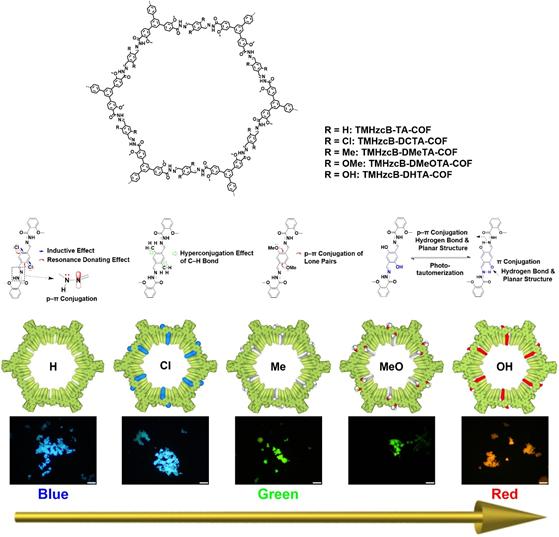Researchers develop a strategy that allows a single family of polymeric materials to emit light in any of the three primary colors

Credit: Zhongping Li and Yuki Nagao from Japan Advanced Institute of Science and Technology
Ishikawa, Japan – Many researchers in the field of materials science constantly seek novel and versatile platforms that can be used to tailor materials to match their intended use. One example of this are covalent organic frameworks (COFs), an emerging class of crystalline porous polymers with a favorable set of fundamental properties, namely crystallinity, stability, and porosity. This combination makes them, in theory, adjustable to many modern applications. Unfortunately, owing to the way COFs are usually obtained, these properties are not very pronounced, resulting in unstable, low-crystallinity solids with limited porosity.
At the Japan Advanced Institute of Science and Technology, Dr. Zhongping Li, Associate Professor Yuki Nagao, and colleagues are trying to put an end to this issue and showcase the true potential of COFs. In their latest study, which was published in Angewandte Chemie International Edition as Very Important Paper, Dr. Nagao, Professor Donglin Jiang at the National University of Singapore, and his team devised a novel strategy for easily tuning the light-emitting properties of hydrazone-linked COFs to produce red, green, or blue (RGB) light by using a single material. This work was the result of a lot of efforts by many researchers including first-author Zhongping Li, Keyu Geng, Ting He, Ke Tian Tan, Ning Huang, Qiuhong Jiang, and Donglin Jiang at the National University of Singapore.
The researchers had been exploring a new concept that involves introducing atoms or small molecular groups into the pore walls of COFs. Though the changes in composition are relatively minor, the orderly introduction of these groups in surface sites causes drastic effects in the electronic structure of the entire molecule, altering some of its physicochemical properties. Without really expecting it, the researchers found that the small perturbations introduced in single surface sites greatly modified the light-emission characteristics of hydrazone-linked COFs.
More specifically, by introducing hydrogen, chlorine, methoxy, methyl, or hydroxy surface sites on the pore walls of COFs (see Figure 1), the team produced compounds that could be fine-tuned to emit light at various distinct frequencies within the RGB spectrum. Surprisingly, these COFs are among the few known material frameworks that can be easily tailored to emit any one of the three primary colors, and even colors in-between (see Figure 2). This is in stark contrast to most available RGB technologies, which require different materials to produce the three primary colors. “Thanks to the exciting features we observed, COF-based materials offer a solution to the low tunability problems found in organic/polymeric light-emitting materials,” remarks Dr. Li, “By introducing perturbations with multiple wall surface sites, our frameworks can be used to edit the light-emission of materials to achieve any given color in a pre-designable and digital way.”
Importantly, aside from these useful color tunability properties, the synthesized COFs were also up there in terms of luminescence, stability, and sensitivity to guest molecules. This combination of features makes the proposed framework especially attractive for light-emitting and sensing implementations using organic and polymeric materials, as well as for other types of applications, as Dr. Li explains: “Our perturbation strategy of introducing single atoms or small groups to induce electronic effects is compatible with further functionalization and should be widely applicable to other types of COFs.”
It’s possible that the strategy devices in this study will shape a new regime in light-emitting organic materials, which shall be useful for highly sophisticated applications and daily-life devices alike. Further refinement of similar methods will let us truly harness the power that even small, yet rational changes can have in the macroscopic behavior of certain materials.
###
Reference
Title of original paper: “Editing Light Emission with Stable Crystalline Covalent Organic Frameworks via Wall Surface Perturbation”
Journal: Angewandte Chemie International Edition
DOI: 10.1002/anie.202107179
Funding information:
This work is supported by an MOE tier 1 grant (R-143-000-A71-114) and a NUS start-up grant (R-143-000-A28-133).
About Japan Advanced Institute of Science and Technology, Japan
Founded in 1990 in Ishikawa prefecture, the Japan Advanced Institute of Science and Technology (JAIST) was the first independent national graduate school in Japan. Now, after 30 years of steady progress, JAIST has become one of Japan’s top-ranking universities. JAIST counts with multiple satellite campuses and strives to foster capable leaders with a state-of-the-art education system where diversity is key; about 40% of its alumni are international students. The university has a unique style of graduate education based on a carefully designed coursework-oriented curriculum to ensure that its students have a solid foundation on which to carry out cutting-edge research. JAIST also works closely both with local and overseas communities by promoting industry-academia collaborative research.
About Associate Professor Yuki Nagao from Japan Advanced Institute of Science and Technology, Japan
Dr. Yuki Nagao is an Associate Professor at the Japan Advanced Institute of Science and Technology, Japan since 2012. He obtained his B.S. and M.S. from University of Tsukuba, Japan in 2001 and 2003, respectively and his Ph.D. from Kyushu University, Japan in 2006. He specializes in designing polymer materials conducive to interface proton transport with a focus on developing proton batteries and fuel cells. He has published over 100 papers with over 1400 citations to his credit. For more information about his research, visit: https://www.jaist.ac.jp/english/areas/mc/laboratory/nagao.html
Media Contact
Yuki Nagao
[email protected]
Related Journal Article
http://dx.




